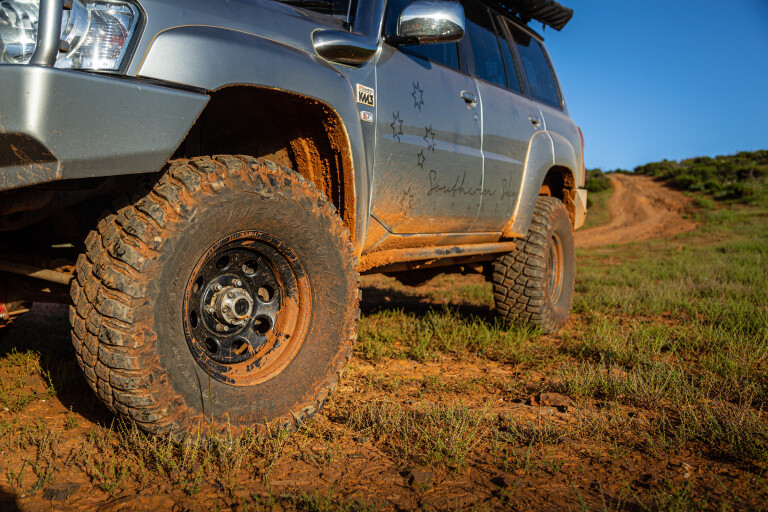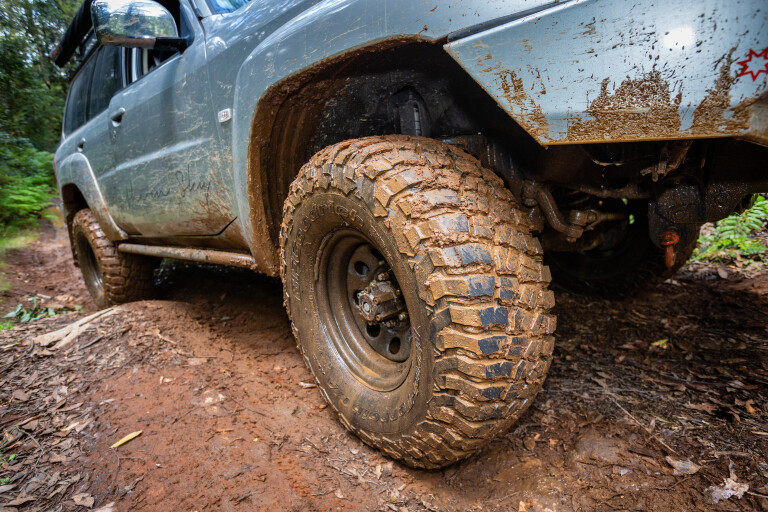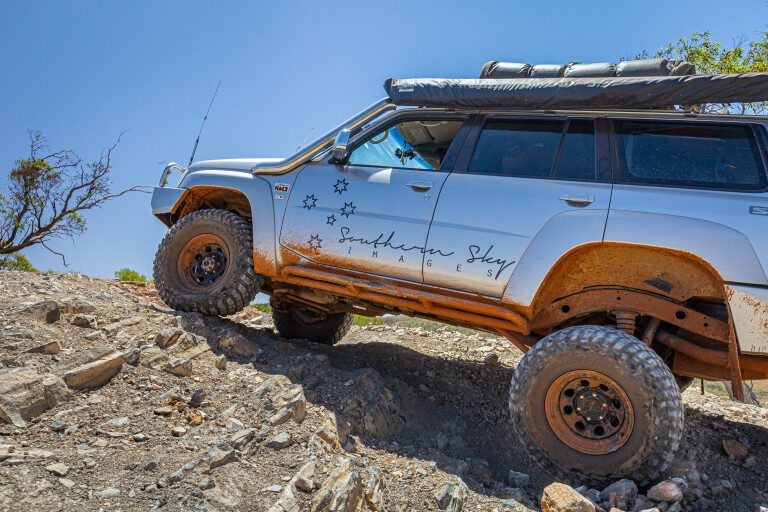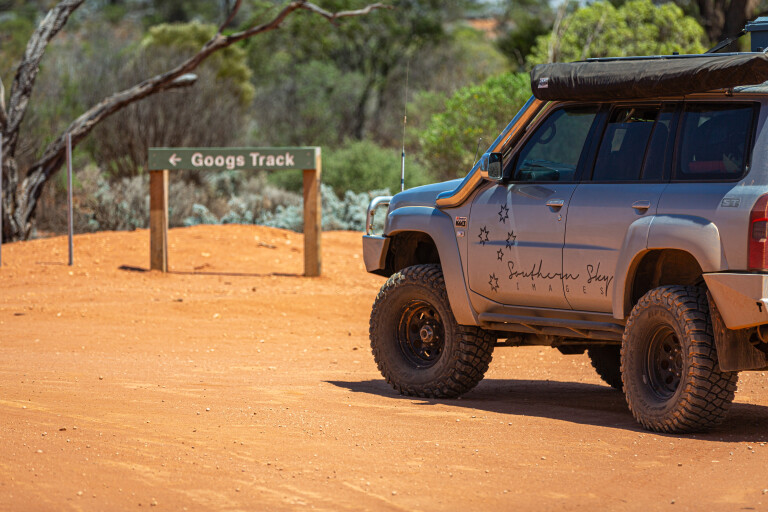
THE lines are becoming blurred … and that’s a great thing for the 4x4 owner. Several years ago, BFG launched the successor to the KM2 which in itself was a very solid tyre throughout its lifespan.
So, it was somehow surprising that the KM3 managed to raise the eyebrows of many experienced 4x4 experts. I mean we all expected great things from the KM3, considering its lineage, but I can still recall the moment I realised how damn quiet this thing was on the tarmac. This was an aggressive mud pattern with all the right stuff, like construction, advanced compound and sidewall armour, and yet it was quiet!
What was this sorcery? And would it last after a solid off-road wear-in period? Well, after 80,000-odd kilometres (and including my current second set) driving every type of terrain you can experience in this country, I can report on its long-term performance. Let’s break it down …

MUD
WELL, you would expect it to work well in mud and yes it does, very well indeed. Ejection of the sticky stuff that otherwise turns your tread into a slick is excellent, even at low wheel rpm.
The little bars that fill the tread gaps, the wide open blocks and the flexible compound and blocks all seem to do their jobs well resulting in good directional control, steerage and most importantly grip. It equates to very confident and effective mud driving.
The sidewall technology really bites in at low pressures, when the tread is flat against the ground, and especially in ruts, rounding out this tyre’s mud prowess.

SAND
HOW do they perform compared to other muddies? Just fine. To be honest I could not tell if they were better or worse, I’ve found the biggest help on sand is to lower tyre pressure no matter the tyre, so that’s
exactly what I did, same as always.
Driving sand is easy no matter the tyre if you are running the right pressure. I had no issues at all driving the softest of desert dunes and beaches. The only thing I did note was that I had to drop pressure more than in the past with older-technology tyres to get a good bagged-out tyre.
Modern sidewalls are stiffer than they used to be for sure and despite the lower pressure, that stronger sidewall seems to also make for a stronger bead connection, meaning I have not rolled a bead despite some aggressive beach driving.
A Mud Terrain is not ideal for sand driving. Why? Ideally you want as large a footprint on the ground as possible to evenly spread the load of the vehicle while not digging into the surface. You want low rolling-resistance and ‘floatation’. The open blocks of a muddie allow the tyre to sink in straight away, and they also increase rolling resistance, so, sand is not the tyre type’s forte at all.

DIRT AND GRAVEL
THIS is an area which I find really interesting with a mud terrain. So, how did the KM3s fare? Best I have driven, hands-down.
On a multitude of gravel and dirt roads with varying levels of corrugation or clay content I never felt unsafe, even when I deliberately pushed them hard with steering input, braking, acceleration and combinations of all inputs.
Lateral and directional stability are fantastic, it is a driver’s tyre, and by that I mean it allows the driver to not have to worry about traction in what is arguably the most driven type of terrain, and I love that.

ROCK
FROM smooth river rock to the sharp pointy stuff that you find in the Flinders Ranges, the level of grip is excellent. Would I say it is better than the rest? No, I cannot say that definitively.
In some cases, it comes down to soft vs hard compound and there are some specialty tyres that offer excellent grip on rock at the expense of mileage, but to have a tyre with top-tier grip on rock, and have it come out the other side without tears and rips in the tread blocks is impressive.
Its willingness to ‘mould’ itself to the terrain (at correct pressures – as for any other tyre) means it is a handy asset for the driver, offering plenty of useable surface to aid traction.

HIGHWAY
EASILY the best mud terrain on the tarmac, for two reasons. First, it is not noisy like a muddie of old design. It is surprisingly quiet with excellent harmonics, and I can tell you it did not get noticeably noisier with wear throughout the lifespan.
Second, the lateral and directional grip are excellent with no obvious weak points. Many mud-terrains have a weakness, be it a tendency to break traction sideways or be poor in braking, particularly in the wet.
This tyre’s tread pattern in combination with the grippy silica compound (which acts at a microscopic level with the road surface) is very well-rounded.

WEAR AND PUNCTURES
THE golden question is mileage right? Hmmm yes, it is, but it isn’t either …
I don’t want to leave you hanging, so I will say I predict more than 70,000km and more if you rotate, balance and run correct pressure. That includes a majority of off-roading and a willingness to run down to a legal but pretty useless level for serious touring.
But I cannot say for sure; I replace my tyres well before they reach the twilight years. What I can say with certainty is this; they are one of the best two wearing muddies I have run but they have offered the best performance over that time by far, which is the most important element for me. So, no, they won’t chip, fall apart or fail like some others have done over time, they offer excellent mileage and overall class-leading performance.
I have not had a failure or single puncture over the two sets. Part luck maybe, but I suspect it is running correct tyre pressure in conjunction with solid carcass construction. I have given the tyres plenty of opportunity to fail with the terrain I have driven but once again, it’s a driver’s tyre.
The fact I am not sweating about punctures when I travel cross country (i.e. not following tracks) across the deserts nor have to worry about my mate Stephan who runs the same on his rig, means we get to enjoy the driving and experience that much more. Worrying about the tyres holding up is not a pressing concern for the work we do, running it as a weekender and daily driver is a no-brainer, it is a great tyre.
OVERALL
THE KM3 is an excellent off-road tyre for the Australian environment. Its performance over any type of terrain is solid and class-leading in nearly every category. It will take an exceptional new (future) tyre to see me bolting on a different pattern.
PRESSURE
WHEREVER I go, I adjust tyre pressures to suit the terrain and vehicle weight. This is the single-most important factor in extracting the best performance from any type of tyre. I also rotate tyres about every 7-10,000km (better yet would be every 5000km) and have a re-balance done with it.

COMMENTS